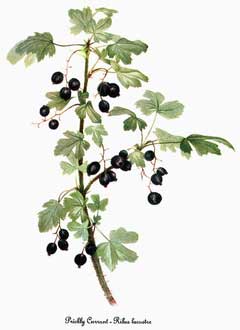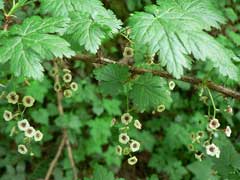 |
|
http://commons.wikimedia.org/wiki/File:Ribes_lacustre,_by_Mary_Vaux_Walcott.jpg |
 |
| http://en.wikipedia.org/wiki/User_talk:Wsiegmund |
Translate this page:
Summary
Physical Characteristics

 Ribes lacustre is a deciduous Shrub growing to 1.5 m (5ft).
Ribes lacustre is a deciduous Shrub growing to 1.5 m (5ft).
See above for USDA hardiness. It is hardy to UK zone 4. It is in flower from April to May. The species is hermaphrodite (has both male and female organs) and is pollinated by Insects.
Suitable for: light (sandy), medium (loamy) and heavy (clay) soils and prefers well-drained soil. Suitable pH: mildly acid, neutral and basic (mildly alkaline) soils. It can grow in semi-shade (light woodland) or no shade. It prefers moist soil.
UK Hardiness Map
US Hardiness Map
Synonyms
R. oxyacanthoides lacustris. Pers.
Plant Habitats
Woodland Garden Sunny Edge; Dappled Shade; Shady Edge;
Edible Uses
Edible Parts: Fruit
Edible Uses:
Fruit - raw or cooked[2, 3, 85, 101, 257]. Tart and very juicy[183]. The fully ripe fruit has an agreeable flavour[256]. When crushed the fruit has a foul odour[43] but when eaten by the handful the odour is inoffensive (this sounds a bit strange!) and when cooked they make a good sauce[183]. The fruit can also be dried for later use or used to make jams and preserves[257]. The fruit is about 5mm in diameter[200] and is covered with weak gland-tipped bristles[235].
References More on Edible Uses
Medicinal Uses
Plants For A Future can not take any responsibility for any adverse effects from the use of plants. Always seek advice from a professional before using a plant medicinally.
Analgesic Birthing aid Laxative Ophthalmic Stomachic
The leaves or the bark can be chewed and then placed on sores caused by the prickles of this plant[257]. A decoction of the bark has been used as a wash for sore eyes[257]. The decoction has also been taken by women during labour to ease the birth[257]. A decoction of the root can be taken several times a day as a treatment for constipation[257]. A decoction of the twigs has been taken in the treatment of general body aches[257]. A decoction of dried branches has been used in the treatment of stomach complaints, diarrhoea and colds[257].
References More on Medicinal Uses
The Bookshop: Edible Plant Books
Our Latest books on Perennial Plants For Food Forests and Permaculture Gardens in paperback or digital formats.

Edible Tropical Plants
Food Forest Plants for Hotter Conditions: 250+ Plants For Tropical Food Forests & Permaculture Gardens.
More

Edible Temperate Plants
Plants for Your Food Forest: 500 Plants for Temperate Food Forests & Permaculture Gardens.
More

More Books
PFAF have eight books available in paperback and digital formats. Browse the shop for more information.
Shop Now
Other Uses
Needles String
The roots have been boiled with cedar (Juniperus spp, Thuja sp.) and wild rose (Rosa spp) roots, then pounded and woven into rope[257]. The sharp thorns have been used as probes for boils, for removing splinters and for tattooing[257].
Special Uses
References More on Other Uses
Cultivation details
Easily grown in a moisture retentive but well-drained loamy soil of at least moderate quality[11, 200]. Plants are quite tolerant of shade though do not fruit so well in such a position[11]. Hardy to about -20°c[200]. Although this plant has spines, it belongs to the blackcurrant section of the genus[101]. Plants can harbour a stage of 'white pine blister rust', so they should not be grown in the vicinity of pine trees[155]. Plants in this genus are notably susceptible to honey fungus[200].
References Carbon Farming Information and Carbon Sequestration Information
Temperature Converter
Type a value in the Celsius field to convert the value to Fahrenheit:
Fahrenheit:
The PFAF Bookshop
Plants For A Future have a number of books available in paperback and digital form. Book titles include Edible Plants, Edible Perennials, Edible Trees,Edible Shrubs, Woodland Gardening, and Temperate Food Forest Plants. Our new book is Food Forest Plants For Hotter Conditions (Tropical and Sub-Tropical).
Shop Now
Plant Propagation
Seed - best sown as soon as it is ripe in the autumn in a cold frame. Stored seed requires 4 - 6 months cold stratification at about 0°c and should be sown as early in the year as possible[113, 164]. Under normal storage conditions the seed can remain viable for 17 years or more. Prick out the seedlings into individual pots when they are large enough to handle and grow them on in a cold frame for their first winter, planting them out in late spring of the following year. Cuttings of half-ripe wood, 10 - 15cm with a heel, July/August in a frame[78, 113]. Cuttings of mature wood of the current year's growth, preferably with a heel of the previous year's growth, November to February in a cold frame or sheltered bed outdoors[78, 200].
Other Names
If available other names are mentioned here
Native Range
NORTHERN AMERICA: Canada (Northwest Territories, Yukon, Québec, Nova Scotia, Ontario, Prince Edward Island, New Brunswick, Newfoundland and Labrador, Saskatchewan, Alberta, Manitoba, British Columbia), United States (Alaska, Connecticut, Maine, Massachusetts, Michigan (north), New Hampshire, New York, Pennsylvania, Vermont, West Virginia, Minnesota (north), South Dakota (southwest), Wisconsin, Colorado (west), Idaho, Montana, Oregon, Washington, Wyoming, California (north), Utah (north))
Weed Potential
Right plant wrong place. We are currently updating this section.
Please note that a plant may be invasive in one area but may not in your area so it's worth checking.
Conservation Status
IUCN Red List of Threatened Plants Status :

| Related Plants
|
| Latin Name | Common Name | Habit | Height | Hardiness | Growth | Soil | Shade | Moisture | Edible | Medicinal | Other |
| Embelia ribes | False black pepper, White-flowered Embelia | Climber | 15.0 |
10-12
| F | LMH | S | M | 3 | 4 | 2 |
| Rheum ribes | | Perennial | 1.5 |
5-9
| | MH | SN | DM | 2 | 0 | |
| Ribes aciculare | | Shrub | 1.0 |
3-7
| | LMH | SN | M | 3 | 0 | |
| Ribes alpinum | Alpine Currant | Shrub | 1.2 |
2-7
| M | LMH | SN | M | 3 | 0 | 4 |
| Ribes altissimum | | Shrub | 3.0 |
5-9
| | LMH | SN | M | 3 | 0 | |
| Ribes ambiguum | | Shrub | 0.6 |
5-9
| | LMH | SN | M | 2 | 0 | |
| Ribes americanum | American Blackcurrant | Shrub | 1.8 |
-
| | LMH | SN | M | 2 | 1 | |
| Ribes aureum | Golden Currant | Shrub | 2.4 |
3-8
| F | LMH | SN | DM | 4 | 1 | 2 |
| Ribes bracteosum | Stink Currant | Shrub | 2.5 |
6-9
| | LMH | N | M | 2 | 1 | |
| Ribes burejense | Bureja gooseberry, | Shrub | 1.0 |
4-8
| | LMH | SN | M | 4 | 0 | 0 |
| Ribes californicum | Hillside Gooseberry | Shrub | 0.0 |
6-9
| | LMH | N | M | 2 | 0 | |
| Ribes cereum | Wax Currant | Shrub | 1.8 |
4-8
| | LMH | N | DM | 2 | 1 | |
| Ribes curvatum | Granite gooseberry | Shrub | 1.0 |
6-9
| | LMH | SN | M | 3 | 0 | |
| Ribes cynosbati | Dogberry, Eastern prickly gooseberry | Shrub | 1.5 |
0-0
| | LMH | SN | M | 3 | 1 | 0 |
| Ribes diacanthum | Siberian currant | Shrub | 1.8 |
0-0
| | LMH | SN | M | 2 | 0 | |
| Ribes distans | | Shrub | 0.6 |
4-8
| | LMH | SN | M | 2 | 0 | |
| Ribes divaricatum | Coastal Black Gooseberry, Spreading gooseberry, Parish's gooseberry, Straggly gooseberry | Shrub | 2.7 |
4-8
| | LMH | SN | M | 4 | 1 | 2 |
| Ribes fasciculatum | | Shrub | 1.5 |
4-8
| | LMH | SN | M | 1 | 0 | |
| Ribes fragrans | | Shrub | 0.6 |
3-7
| | LMH | SN | M | 3 | 0 | |
| Ribes gayanum | | Shrub | 1.5 |
7-10
| | LMH | SN | M | 3 | 0 | |
| Ribes glaciale | | Shrub | 3.0 |
-
| | LMH | SN | M | 2 | 0 | |
| Ribes glandulosum | Skunk Currant | Shrub | 0.4 |
-
| | LMH | SN | M | 2 | 1 | 3 |
| Ribes griffithii | | Shrub | 2.5 |
-
| | LMH | SN | M | 2 | 0 | |
| Ribes himalense | | Shrub | 2.0 |
5-9
| | LMH | SN | M | 3 | 1 | |
| Ribes hirtellum | Currant-Gooseberry, Hairystem gooseberry | Shrub | 1.0 |
4-8
| | LMH | N | M | 3 | 0 | 0 |
| Ribes horridum | | Shrub | 1.5 |
-
| | LMH | SN | M | 3 | 0 | |
| Ribes hudsonianum | Hudson Bay Currant, Northern black currant, Western black currant | Shrub | 1.0 |
0-0
| | LMH | SN | M | 2 | 1 | |
| Ribes inebrians | Whisky Currant | Shrub | 2.0 |
4-8
| | LMH | SN | M | 2 | 1 | |
| Ribes inerme | Whitestem Gooseberry, Klamath gooseberry | Shrub | 2.0 |
5-9
| | LMH | SN | M | 2 | 0 | |
| Ribes irriguum | Idaho Gooseberry | Shrub | 3.0 |
-
| | LMH | SN | M | 2 | 1 | |
|
|
Growth: S = slow M = medium F = fast. Soil: L = light (sandy) M = medium H = heavy (clay). pH: A = acid N = neutral B = basic (alkaline). Shade: F = full shade S = semi-shade N = no shade. Moisture: D = dry M = Moist We = wet Wa = water.
Now available:
Food Forest Plants for Mediterranean Conditions
350+ Perennial Plants For Mediterranean and Drier Food Forests and Permaculture Gardens.
[Paperback and eBook]
This is the third in Plants For A Future's series of plant guides for food forests tailored to
specific climate zones. Following volumes on temperate and tropical ecosystems, this book focuses
on species suited to Mediterranean conditions—regions with hot, dry summers and cool, wet winters,
often facing the added challenge of climate change.
Read More
Expert comment
Author
(Pers.)Poir.
Botanical References
1143200
Links / References
For a list of references used on this page please go here
Readers comment
| Add a comment |
|
If you have important information about this plant that may help other users please add a comment or link below. Only comments or links that are felt to be directly relevant to a plant will be included. If you think a comment/link or information contained on this page is inaccurate or misleading we would welcome your feedback at [email protected]. If you have questions about a plant please use the Forum on this website as we do not have the resources to answer questions ourselves.
* Please note: the comments by website users are not necessarily those held by PFAF and may give misleading or inaccurate information.
To leave a comment please Register or login here All comments need to be approved so will not appear immediately.
|
|